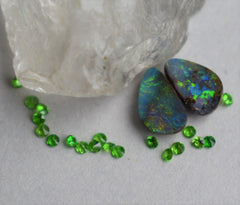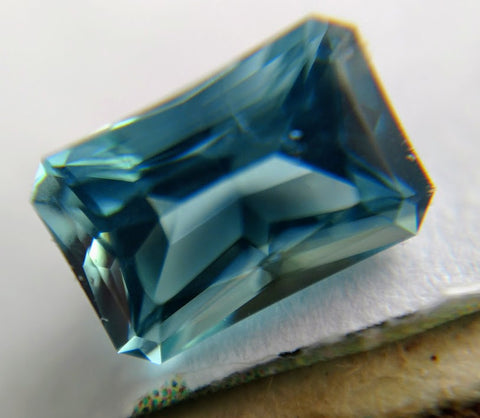Nature doesn’t make it easy, does it? Is it a ruby or a sapphire? Is the Paraiba more greenish or more blueish? Does the tourmaline have a sooty appearance in indoor lighting? Is the color change on this garnet complete and does it change from a teal blue to a purple or a teal green to a red? Does the sapphire have secondary hues of violet or purple? Does the spinel glow, does it have open color?
As a gemstone seller, I have faced all these questions and more. Just last week I got a request for a round matched pair of 5mm gems – seafoam color. When we finally sorted out what seafoam green meant, I realized I would have called that a lighter teal blue-green, and my idea of seafoam was more greenish than hers (maybe we were thinking of different vacation spots, lol). Which is fine, there’s lots of disagreement on color names, as is evidenced when you get color samples for repainting your wall at Home Depot or Lowes.

Does this sapphire have secondary hues of violet?

Seafoam colors, or mint? Both?

Which, if any, of these tourmalines is seafoam color?

Is this paraiba more greenish or more turquoise?

Do you think this paraiba is blue or turquoise?

GIA has developed a helpful color reference booklet and chart. Below is the link to the booklet: https://www.gia.edu/doc/
Another question I often face is about extinction – this happens at least twice a month, no joke. How much extinction is there, is it half the stone, or the entire stone, the top half or the bottom..? All my photos are taken in natural lighting with the light coming from one direction (namely outdoors). I’ve tried taking photos with the lighting behind the stone but that doesn’t look good. In order to avoid half of the gem looking dark, I have to go outside in the afternoon, put the stone on my outdoor table with the lighting directly behind me. But sometimes that provides too much light and no amount of correction fixes it (it’s also rather cold in the winter and we don’t like losing stones in the front yard). And ANY oval stone (and many pears) will look dark on one side if the light is not directly behind you. Lightboxes have not worked for me, artificial light doesn’t work for many stones (i.e. mandarin garnet looks washed out, mint garnet looks too gray). So you make do and hope that your additional description sheds more light onto what the stone looks like – pun intended. This can backfire if the description and the photos are too far apart. Needless to say we spend oodles of time doing photos and listings, so at times trying to get it just right, especially with cheaper gems, takes more time than I can charge for the gem. Nobody wants to pay $25 in photography time for a $10 gem.

Does this Burmese spinel have extinction? Open Color? Left photo: indoor natural lighting coming from the right, right photo: outdoor natural lighting from behind the camera.

Does this Mahenge spinel have extinction? Left photo: indoors natural lighting from the right. Right photo: outdoor natural lighting from behind the camera.
Here are some additional challenges to accurate representation of gems:
- Monitors vary and not everyone knows how to balance out the colors when they get a new computer (there’s a function for this in the control panel, under color management).
- Cameras differ and so do the programs you can use to color correct photos. My Motorola photos do not look like the pictures I take with my Nikon, my older iPad basically sucks. My old “Picasa” software is no longer supported and I really liked the way it color corrected.
- Natural lighting conditions vary from place to place and season to season, and with the weather. My Tucson and Las Vegas photos are usually much brighter than my New Jersey photos. Dimmer winter light often brings out grey casts in sapphires, tourmalines and spinel. Showing color change requires very artificial conditions that do not obtain in most homes (i.e. fluorescent and LED lighting do not show color change, and dark regular incandescent light doesn’t show much color in the first place). Dudley Blauwet always tells me which Kelvin value (the unit of measurement used to describe the hue of a light source) can be seen in particular areas in Sri Lanka and that those conditions are different from over here. Well that’s very informative but doesn’t provide much practical advice on what to do, neat travel locations excluded.

Paraiba in direct sunlight taken in Tucson, AZ

Morganite in indirect sunlight taken in Tucson, AZ

Paraiba taken indoors without natural lighting
- Color vision differs from person to person. I don’t just mean that some people are color blind, I mean that most of us do not see everything on the color spectrum. If you want to freak yourself out, try one of these color vision tests online: http://www.color-blindness.com/ishihara-38-plates-cvd-test/#prettyPhoto
- Historical gem classifications and chemical ones do not overlap. We already know that most bright red rubies from old crown jewels are actually spinel, which can often be found in the same deposits. But it also used to be thought that ruby and sapphire were two different minerals. So when you get borderline colors, you have to make an executive decision as to which is which. And even depending on where these distinctions are made (i.e. India or over here) you get different classifications, which in turn affect price. The recent Madagascan rubies I got from Dudley Blauwet evidence this. Dudley told me he had a hard time deciding where to draw the line to pink sapphire, but knowing that he’s better at this than I am, I kept his classifications. This doesn’t mean that GIA would agree, however. And many labs use different color names for their classifications. For example, a "purplish pink" ruby at GIA is a "pinkish red" ruby at AGL and Gubelin. And a GIA "red ruby" is a often "pigeon blood red" at GRS. So if you want your ruby to be pigeon blood red you can't give it to GIA. One almost gets the sense that these gems change color as they travel. However, the difference in terminology has to do with what each lab considers the scientifically correct color term.

What's the color of this ruby?
- Finally, here’s a real doozy for you. Some color names are trademarked. So “grape garnet” cannot be used in a description of purple Mozambique garnet, unless you are Parle jewelry. You can only call it “purple garnet” or “grape colored garnet” (which is, incidentally, the same gem). “Mint” garnet is currently in the process of facing the same fate, so in future I will have to say “mint color” or “light color tsavorite” or light “grossular garnet.” “Lotus garnet” is already the trademark for Malaya garnets. So gem colors can be trademarked just like cuts, i.e. “Asscher”.
So what can a prospective buyer, and especially one that is new to colored stones, do? You can always ask a vendor for clarification on the description, ask for additional photos or a video, and last but not least, you can look at some well known shops in the retail world and make price and quality comparisons. Swala, Pala, Gemselect, Wildfish, and many others have good photos and descriptions that are helpful for price and color comparisons. And of course, you should go to gem shows in your area, if possible, or even just some shops that have a few colored stones, and start looking. The more time you spend looking at things, the better you get at making judgments of your own.

What are the colors of he two sapphires on the left?



















